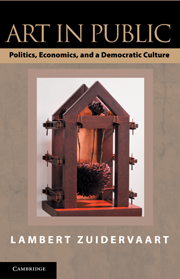10 - Transforming Cultural Policy
Published online by Cambridge University Press: 05 June 2012
Summary
In the wood there are paths, mostly overgrown, that come to an abrupt stop where the wood is untrodden. They are called Holzwege.
Martin HeideggerFrom culture wars to a democratic culture – that is the trajectory of this book. Might it also be the direction in which cultural policy needs to be transformed? Before I take up this question, let me first review the paths we have taken. While some have been fairly straightforward, others have meandered or stopped short of their destination. They may seem like what Martin Heidegger calls Holzwege – paths that head toward “a clearing in the forest where timber is cut” but have become “overgrown” and perhaps lead “nowhere.” So I should retrace our steps to see where this book’s pathways have led us. Then I can present my sociocultural case for government arts funding and explore some implications for cultural policy.
Pathways
We began at a place familiar to many in North America: an ongoing debate over government arts funding that became especially heated in the late 1980s and early 1990s. Chapter 1 describes three conceptual polarities in this debate: government versus market, freedom versus authority, and provocation versus decadence. It also identifies three underlying assumptions, common to both sides of the debate, which reflect outdated and questionable views of the state, the arts, and a democratic society. The first assumption is the general acceptance of a politico-economic system in which government funding primes the pump for an art world dominated by corporate business interests. The second is an individualistic view of artists and their work. The third assumption is a vanguardist understanding of contemporary art’s role in society.
- Type
- Chapter
- Information
- Art in PublicPolitics, Economics, and a Democratic Culture, pp. 293 - 316Publisher: Cambridge University PressPrint publication year: 2010



